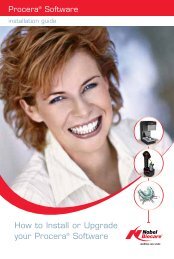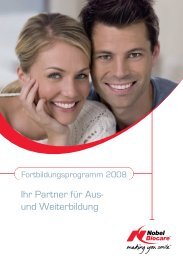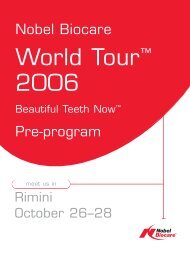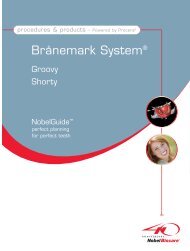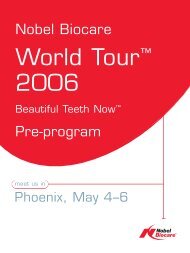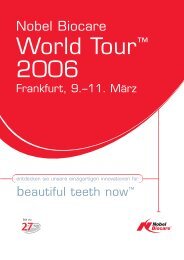Alumina and Zirconia - Nobel Biocare
Alumina and Zirconia - Nobel Biocare
Alumina and Zirconia - Nobel Biocare
Create successful ePaper yourself
Turn your PDF publications into a flip-book with our unique Google optimized e-Paper software.
<strong>Alumina</strong> <strong>and</strong> <strong>Zirconia</strong><br />
The increased dem<strong>and</strong> for improved esthetics, along with the preference for non-metal<br />
restorative materials have increased the use of dental ceramics. The ceramic materials used for<br />
<strong>Nobel</strong> <strong>Biocare</strong>’s all-ceramic crowns, bridges, laminates <strong>and</strong> abutments consist of densely<br />
sintered, high purity (99.5%) aluminum oxide (alumina) <strong>and</strong> yttria-stabilized zirconium oxide<br />
(Y-TZP zirconia). These ceramic materials possess several desirable characteristics for use in<br />
modern dentistry, including biocompatibility <strong>and</strong> good mechanical properties 1-16 .<br />
<strong>Alumina</strong><br />
Studies focused on evaluating the clinical performance of all-ceramic alumina crowns,<br />
bridges, <strong>and</strong> abutments in dental practice have shown good results 2,17-45 . Cumulative success<br />
rates of 98% <strong>and</strong> 92% after 5 <strong>and</strong> 10 years, respectively, have been reported for alumina<br />
crowns 22,26,30,31 . Tests have shown that the alumina crowns <strong>and</strong> bridges exceed the<br />
biomechanical requirements for all-ceramic fixed partial dentures 33 . Moreover, both short <strong>and</strong><br />
long-term clinical studies have shown good results for the alumina abutments 35-45 ; a<br />
cumulative success rate of 98% after 5 years 43 , favourable marginal bone levels, <strong>and</strong> healthy<br />
surrounding soft tissue have been reported 41-43 .<br />
<strong>Zirconia</strong><br />
<strong>Zirconia</strong> has a flexural strength <strong>and</strong> fracture toughness almost twice as high as that of<br />
alumina, which makes zirconia very resistant to masticatory forces, with maintained exact<br />
precision of fit 46,47,56 . Clinical studies aiming at evaluating zirconia abutments have shown<br />
high success rates <strong>and</strong> good esthetic results, with healthy mucosal conditions <strong>and</strong> stable<br />
marginal bone levels 48-52 . Furthermore, compared to titanium, zirconia has been shown to<br />
accumulate less bacteria in vivo in terms of presence <strong>and</strong> total number of potential putative<br />
pathogens 53,54 . Data also reveal that the tissues around zirconia healing caps undergo a lower<br />
rate of inflammation-associated processes compared to titanium 55 . Clinical studies evaluating<br />
the long-term performance of zirconia crowns <strong>and</strong> bridges are ongoing.<br />
References<br />
1. Al-Dohan HM, Yaman P, Dennison JB, Razzoog ME, Lang BR. Shear strength of core-veneer interface in bi-layered<br />
ceramics. J Prosthet Dent 2004;91(4):349-55.<br />
2. Andersson M, Odén A. A new all-ceramic crown. A dense-sintered, high-purity alumina coping with porcelain.<br />
Acta Odontol Sc<strong>and</strong> 1993;51:59-64.<br />
3. Anusavice KJ. Degradability of dental ceramics. Adv Dent Res 1992;6:82-9.<br />
4. Chai J, Takahashi Y, Sulaiman F, Chong K, Lautenschlager EP. Probability of fracture of all-ceramic crowns. Int J<br />
Prosthodont 2000;13(5):420-4.<br />
5. Esquivel-Upshaw JF, Chai J, Sansano S, Shonberg D. Resistance to staining, flexural strength, <strong>and</strong> chemical<br />
solubility of core porcelains for all-ceramic crowns. Int J Prosthodont 2001;14(3):284-8.<br />
6. Harrington Z, McDonald A, Knowles J. An in vitro study to investigate the load at fracture of Procera AllCeram<br />
crowns with various thickness of occlusal veneer porcelain. Int J Prosthodont 2003;16(1):54-8.<br />
GEN 62724 April 2007
7. Hegenbarth EA. Procera aluminum oxide ceramics; A new way to achieve stability, precision <strong>and</strong> esthetics in allceramic<br />
restorations. Quintessence Dent Technol 1996;19:21-34.<br />
8. Pallis K, Griggs JA, Woody RD, Guillen GE, Miller AW. Fracture resistance of three all-ceramic restorative systems<br />
for posterior applications. J Prosthet Dent 2004;91(6):561-9.<br />
9. Potiket N, Chiche G, Finger IM. In vitro fracture strength of teeth restored with different all-ceramic crown systems.<br />
J Prosthet Dent. 2004 Nov;92(5):491-5.<br />
10. Snyder MD, Hogg KD. Load-to-fracture value of different all-ceramic crown systems. J Contemp Dent Pract. 2005<br />
Nov 15;6(4):54-63.<br />
11. Thomas P, Barnstorf S, Summer B, Willmann G, Przybilla B. Immuno-allergological properties of aluminium oxide<br />
(Al2O3) ceramics <strong>and</strong> nickel sulfate in humans. Biomaterials. 2003 Mar;24(6):959-66.<br />
12. Wagner WC, Chu TM. Biaxial flexural strength <strong>and</strong> indentation fracture toughness of three new dental core<br />
ceramics. J Prosthet Dent. 1996 Aug;76(2):140-4.<br />
13. Webber B, McDonald A, Knowles J. An in vitro study of the compressive load at fracture of Procera AllCeram<br />
crowns with varying thickness of veneer porcelain. J Prosthet Dent 2003;89(2):154-60.<br />
14. Wood KC, Berzins DW, Luo Q, Thompson GA, Toth JM, Nagy WW. Resistance to fracture of two all-ceramic<br />
crown materials following endodontic access. J Prosthet Dent. 2006 Jan;95(1):33-41.<br />
15. Zeng K, Oden A, Rowcliffe D. Evaluation of mechanical properties of dental ceramic core materials in combination<br />
with porcelains. Int J Prosthodont 1998;11(2):183-9.<br />
16. Zeng K, Oden A, Rowcliffe D. Flexure tests on dental ceramics. Int J Prosthodont 1996;9(5):434-9.<br />
17. Andersson M, Razzoog ME, Oden A, Hegenbarth EA, Lang BR. Procera: a new way to achieve an all-ceramic<br />
crown. Quintessence Int. 1998 May;29(5):285-96.<br />
18. Bonnard P, Hermans M, Adriaenssens P, Daelemans P, Malevez C. Anterior esthetic rehabilitation on teeth <strong>and</strong><br />
dental implants optimized with Procera technology: a case report. J Esthet Restor Dent. 2001;13(3):163-71.<br />
19. Brunton PA, Smith P, McCord JF, Wilson NH. Procera all-ceramic crowns: a new approach to an old problem? Br<br />
Dent J. 1999 May 8;186(9):430-4.<br />
20. Chai J, McGivney GP, Munoz CA, Rubenstein JE. A multicenter longitudinal clinical trial of a new system for<br />
restorations. J Prosthet Dent 1997;77(1):1-11.<br />
21. Fradeani M, D'Amelio M, Redemagni M, Corrado M. Five-year follow-up with Procera all-ceramic crowns.<br />
Quintessence Int. 2005 Feb;36(2):105-13.<br />
22. Galindo ML, Hagmann E, Marinello CP, Zitzmann NU. Long-term clinical results with Procera AllCeram fullceramic<br />
crowns. Schweiz Monatsschr Zahnmed 2006;116:804-809.<br />
23. Haag P, Andersson M, Vult von Steyern P, Odén A. 15 years of clinical experience with Procera® <strong>Alumina</strong>. A<br />
Review. Appl Osseointegrat Res 2004;4:7-12<br />
24. Jokstad A. A split-mouth r<strong>and</strong>omized clinical trial of single crowns retained with resin-modified glass-ionomer <strong>and</strong><br />
zinc phosphate luting cements. Int J Prosthodont. 2004 Jul-Aug;17(4):411-6.<br />
25. Naert I, Van der Donck A, Beckers L. Precision of fit <strong>and</strong> clinical evaluation of all-ceramic full restorations followed<br />
between 0.5 <strong>and</strong> 5 years. J Oral Rehabil. 2005 Jan;32(1):51-7.<br />
26. Oden A, Andersson M, Krystek-Ondracek I, Magnusson D. Five-year clinical evaluation of Procera AllCeram<br />
crowns. J Prosthet Dent 1998;80(4):450-6.<br />
27. Ottl P, Piwowarczyk A, Lauer HC, Hegenbarth EA. The Procera AllCeram system. Int J Periodontics Restorative<br />
Dent 2000;20(2):151-61.<br />
28. Razzoog ME, Lang LA, McAndrew KS. AllCeram crowns for single replacement implant abutments. J Prosthet<br />
Dent 1997;78(5):486-9.<br />
29. Walter MH, Wolf BH, Wolf AE, Boening KW. Six-year clinical performance of all-ceramic crowns with alumina<br />
cores. Int J Prosthodont. 2006 Mar-Apr;19(2):162-3.<br />
30. Zarone F, Sorrentino R, Vaccaro F, Russo S, De Simone G. Retrospective clinical evaluation of 86 Procera<br />
AllCeram anterior crowns on natural <strong>and</strong> implant-supported abutments. Clin Implant Dent Relat Res. 2005; 7<br />
2005;7 (Suppl 1):S95-103.<br />
31. Ödman P, Andersson B. Procera AllCeram crowns followed for 5 to 10.5 years: a prospective clinical study. Int J<br />
Prosthodont. 2001 Nov-Dec;14(6):504-9.<br />
GEN 62724 April 2007
32. Sadan A, Blatz M, Lang B. Clinical considerations for densely sintered alumina <strong>and</strong> zirconia restorations: Part 1.<br />
Int J Periodontics Restorative Dent 2005; 25:213-19.<br />
33. Lang B, Maló P, Guedes C, Wang RF, Kang B, Lang L, Razzoog ME. Procera® AllCeram Bridge. Appl<br />
Osseointegrat Res 2004;4:13-21.<br />
34. Att W, Kurun S, Gerds T, Strub JR. Fracture resistance of single-tooth implant-supported all-ceramic restorations:<br />
an in vitro study. J Prosthet Dent. 2006 Feb;95(2):111-6.<br />
35. Heydecke G, Sieraalta M, Razzoog MF. Evolution <strong>and</strong> use of aluminium oxide single-tooth implant abutments: a<br />
short review <strong>and</strong> presentation of two cases. Int J Prosthodont 2002;15(5):488-93.<br />
36. Kucey BK, Fraser DC. The Procera abutment--the fifth generation abutment for dental implants. J Can Dent Assoc<br />
2000;66(8):445-9.<br />
37. Marchack CB, Yamashita T. Fabrication of digitally scanned custom shaped abutment: a clinical report. J Prosthet<br />
Dent 2001;85(2):113-5.<br />
38. Prestipino V, Ingber A. All-ceramic implant abutments. Esthetic indications. J Esthetic Dentistry 1996;8(6):255-<br />
262.<br />
39. Prestipino V, Ingber A. Esthetic high-strength implant abutments. Part I. J Esthetic Dentistry 1993;5(1):29-36.<br />
40. Prestipino V, Ingber A. Esthetic high-strength implant abutments. Part II. J Esthet Dent 1993;5(2):63-8.<br />
41. Andersson B, Scharer P, Simion M, Bergstrom C. Ceramic implant abutments used for short-span fixed partial<br />
dentures: a prospective 2-year multicenter study. Int J Prosthodont 1999;12(4):318-24.<br />
42. Andersson B, Taylor A, Lang BR, Scheller H, Scharer P, Sorensen JA, Tarnow D. <strong>Alumina</strong> ceramic implant<br />
abutments used for single-tooth replacement: a prospective 1- to 3-year multicenter study. Int J Prosthodont<br />
2001;14(5):432-8.<br />
43. Andersson B, Glauser R, Maglione M, Taylor A. Ceramic implant abutments for short-span FPDs: a prospective 5-<br />
year multicenter study. Int J Prosthodont 2003;16(6):640-6.<br />
44. Henriksson K, Jemt T. Evaluation of custom-made procera ceramic abutments for single-implant tooth replacement:<br />
a prospective 1-year follow-up study. Int J Prosthodont 2003;16(6):626-30.<br />
45. Sadoun M, Perelmuter S. <strong>Alumina</strong>-zirconia machinable abutments for implant-supported single-tooth anterior<br />
crowns. Pract Periodontics Aesthet Dent 1997;9(9):1047-53.<br />
46. Yildirim M, Fischer H, Marx R, Edelhoff D. In vivo fracture resistance of implant-supported all-ceramic<br />
restorations. J Prosthet Dent 2003;90(4):325-31.<br />
47. Sierraalta M, Odén A, Razzoog ME. Material strength of zirconia produced with two methods. J Dent Res<br />
2003;82(Spec Iss A):AADR abstract # 0450<br />
48. Att W, Kurun S, Gerds T, Strub JR. Fracture resistance of single-tooth implant-supported all-ceramic restorations<br />
after exposure to the artificial mouth. J Oral Rehabil 2006;33:380-386.<br />
49. Cibirka RM, Nelson SK, Rueggeberg FA. Examination of the implant-abutment interface after fatigue testing. J<br />
Prosthet Dent 2001;85(3):268-75.<br />
50. Glauser R, Sailer I, Wohlwend A, Studer S, Schibli M, Scharer P. Experimental zirconia abutments for implantsupported<br />
single-tooth restorations in esthetically dem<strong>and</strong>ing regions: 4-year results of a prospective clinical study.<br />
Int J Prosthodont 2004;17(3):285-90.<br />
51. Lang LA, Sierraalta M, Hoffensperger M, Wang RF. Evaluation of the precision of fit between the Procera custom<br />
abutment <strong>and</strong> various implant systems. Int J Oral Maxillofac Implants 2003;18(5):652-8.<br />
52. Tan PL, Dunne Jr JT. An esthetic comparison of a metal ceramic crown <strong>and</strong> cast metal abutment with an all-ceramic<br />
crown <strong>and</strong> zirconia abutment: a clinical report. J Prosthet Dent 2004;91(3):215-8.<br />
53. Scarano A, Piattelli M, Caputi S, Favero GA, Piattelli A. Bacterial adhesion on commercially pure titanium <strong>and</strong><br />
zirconium oxide disks: an in vivo human study. J Periodontol 2004;75(2):292-6.<br />
54. Rimondini L, Cerroni L, Carrassi A, Torricelli P. Bacterial colonization of zirconia ceramic surfaces: an in vitro <strong>and</strong><br />
in vivo study. Int J Oral Maxillofac Implants 2002;17(6):793-8.<br />
55. Degidi M, Artese L, Scarano A, Perrotti V, Gehrke P, Piattelli A. Inflammatory infiltrate, microvessel density,<br />
nitric oxide synthase expression, vascular endothelial growth factor expression, <strong>and</strong> proliferative activity in periimplant<br />
soft tissues around titanium <strong>and</strong> zirconium oxide healing caps. J Periodontol. 2006 Jan;77(1):73-80.<br />
56. Kessler-Liechti G, Mericske-Stern R. Rehabilitation of an abraded occlusion with Procera-ZrO2 all-ceramic crowns.<br />
A case report. Schweiz Monatsschr Zahnmed 2006;116:156-167.<br />
GEN 62724 April 2007




